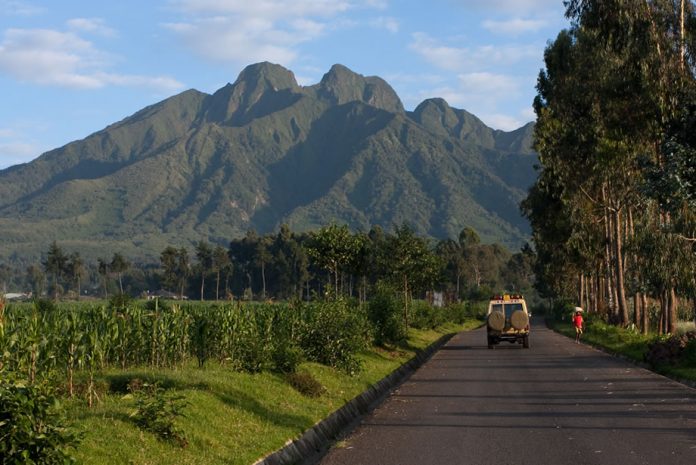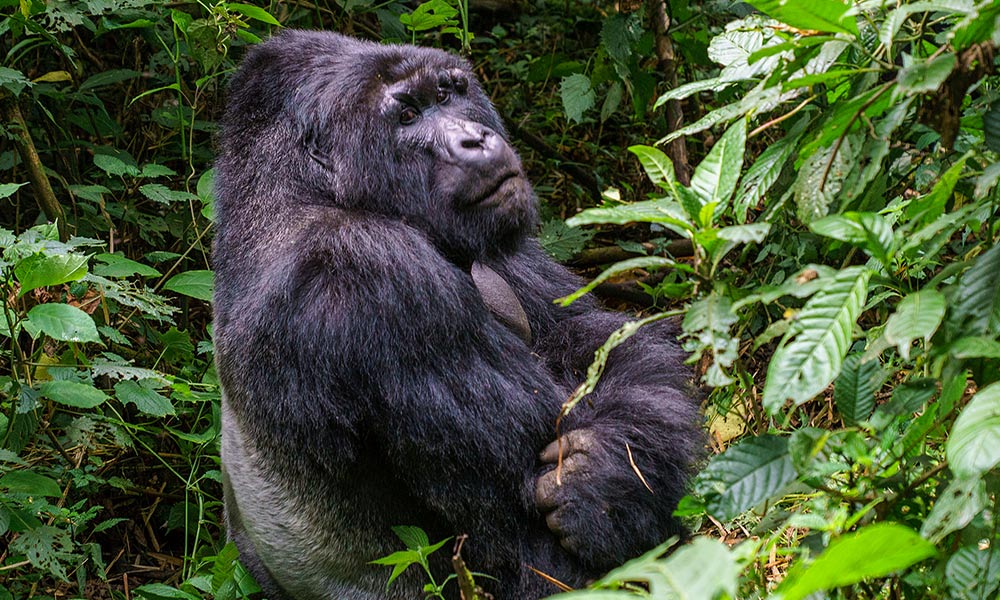I remember when I was about 13; I came across an article about the incredible rare mountain gorillas of central and East Africa. This is something that obviously stuck in my little brain, because when I was thinking about exploring more of Africa in my vacation year, I finally decided to go gorilla tracking and meet these amazing rare great Apes.
My tracking day started as early as 6:00am local time with a hearty breakfast because by 7:00am sharp- with packed lunch I needed to be at the HQ of the Parc National des Volcans in Ruhengeri for briefing. The Volcanoes National Park is the place where Dian Fossey worked and the setting for the famous film Gorillas in the Mist). After getting allocated to the different gorilla groups, we were separated into ten groups of eight trekkers each.
Each trekking group was assigned a guide and a gorilla group to trek, and led into the thick forest. The mountain I climbed formed the border between the Democratic Republic of Congo (DRC), Rwanda and Uganda, and we were told the gorilla group had been spotted at 3000m. We started hiking through the jungle that contain the mud, the mist and this gave us quite an interesting experience.
Later on, about three hours, we found ourselves over 9,000m above sea level, sweaty, out of breath and having been scratched to pieces by the vegetation, put your bags down, “our guide told us quietly” get out your cameras and be very quiet – a gorilla had been spotted! Looking up the steep slope, we could see the dark shape of a juvenile in a tree.
Getting closer, our guide started making ‘soothing gorilla noises’ (or grunting loudly)! I was thrilled to see the dominant male and leader of the group, the Silverback, appeared to take exception to our presence, and started pounding his chest and roaring. Good enough we had been told to stand our ground- that he would do this to intimidate us, just to prove he was bigger and owned the territory, I wasn’t arguing with him — and then shortly he settle down.
Shortly after he had relaxed, a female emerged from the nearby bush behind us, and walked back to the group, brushing past the backs of our legs. Among the rules of the park authorities is that visitors may get no closer than seven meters to the gorillas – which brush past my trouser leg will stay in my mind as one of the most amazing experiences of my life and proud to be part of this Rwanda gorilla tour into the Volcanoes National Park (PNV).
Then we enjoyed the next hour passed far too quickly – taking pictures (no flash, it apparently aggravates the animals) and just watching the children play in the tree branches. However they look intelligent, they care for their young, always pull them back whenever go too far or too close to spectators and I feel incredibly privileged to have spent that hour with these amazing Africa’s gentle giants. Standing before them makes forget all the hassles encountered on your way up the mountain. Wow gorilla safaris are exceptional.
Facts about the Rwandan Mountain Gorillas; A few travel tips about the experience:
The gorillas live in a mountainous, volcanic region called the Virunga, straddling the borders of Uganda, Rwanda and the Democratic Republic of Congo (DRC).
The Virunga gorillas have suffered a combination of habitat loss, illegal poaching, disease and civil unrest, bringing the population close to the brink of extinction in the 1970s and 1980s, but conservation is slowly having a positive effect.
There are now thought to be around 800 gorillas living in the wild, compared to about 550 just a few years ago, with as much as half of the world’s remaining population living in the Virunga Mountains.
The area is remote, and it took days to get there from other tourist areas in Uganda.
The trekking permits aren’t cheap, setting you back about US$750 including the cost of trekking in the Parc National des Volcans in Rwanda. Mgahinga National Park and Bwindi National Park in Uganda charge about US$600.
This price pays for your guide, entrance to the park, and allows you to spend one hour with a gorilla group. It is a lot of money, but most of it is spent on directly conserving the gorilla population and in educating the local people in the importance of conservation in the fragile mountain forest ecosystems of the area.
In Rwanda, there are 13 groups of gorillas, but only 10 are used to tourists, so book early.
Tribal drummers celebrating the birth of an endangered mountain gorilla and Gorilla naming festivities every year called “Kwita Izina” Annual Gorilla naming ceremony.
Rwanda is now a safe destination to travel to, beautiful with numerous rolling hills probably that’s why its termed as “Land of a thousand hills”, Rwanda safari trips majorly feature Gorilla safaris, bird safaris, big game safaris in Akagera national park combined with cultural safaris as well as trips to genocide memorial sites. Relax along beautiful beaches of lake Kivu or Go chimpanzee tracking in Nyungwe forest national park. It is such an incredible memorable experience to be on a Rwanda Safari.












